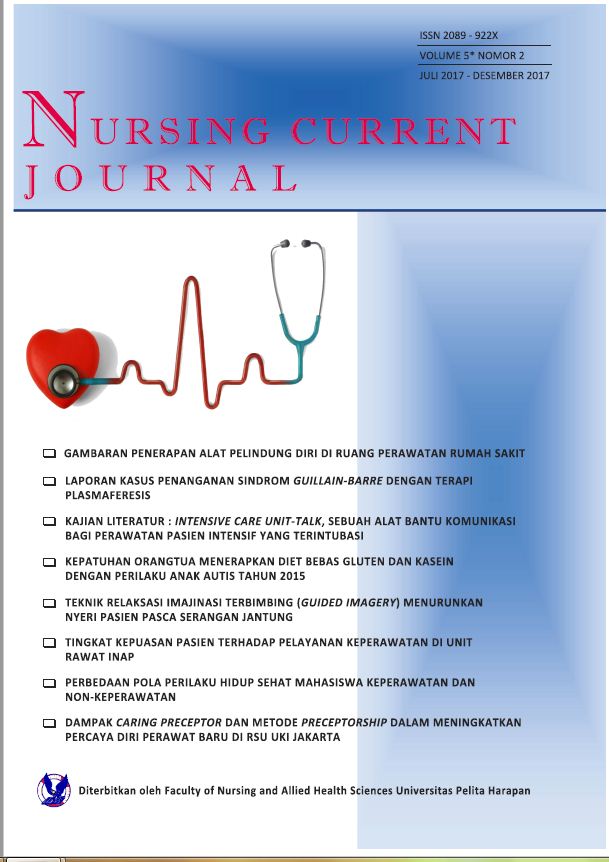LITERATURE STUDY: INTENSIVE CARE UNIT-TALK, A COMMUNICATION AID FOR MAINTENANCE INTUBATED INTENSIVE PATIENTS [KAJIAN LITERATUR: INTENSIVE CARE UNIT-TALK, SEBUAH ALAT BANTU KOMUNIKASI BAGI PERAWATAN PASIEN INTENSIF YANG TERINTUBASI]
DOI:
https://doi.org/10.19166/nc.v5i2.1701Keywords:
Augmented Alternative Communication, Intensive Care Unit, Intubated PatientsAbstract
ICU-Talk technique is a development of Augmented Alternative Communication (AAC) method. This technique provides some features that are compiled with a database computerized. This database has a major vocabulary and vocabulary developed and is highly compatible with all patients. Systematic review to analyze the effectiveness of such devices and the like in communication in an intubated patient..Authors use some search keywords that are "Intensive Care Unit", "communication", "Patient", "intubated", "tool", Augmented Alternative Communicator using boolean "AND". literature sources to be studied is EBSCO, ScienceDirect, aacnjournals, ersjournals. There were 11 articles that have been reviewed. ICU-Talk is a practical design and consists of two interfaces. Many vocabulary is stored in this ICU-Talk database, and its usage can be through touch screen (touch screen), mouse or with one button. Each interface is colored differently and comes with animations and 250 vocabulary, as well as box-shaped and bubbles. The use of these boxes and bubbles makes it easier for users to find words / topics that suit their needs. For hospital, nurses, and nursing students to pay attention to these tools as a forms of communication with patients intubated.
BAHASA INDONESIA Teknik ICU-Talk ini merupakan perkembangan dari metode Augmented Alternative Communication (AAC).Teknik ini menyediakan beberapa fitur yang disusun dengan database secara terkomputerisasi.Database ini memiliki kosakata yang utama dan kosakata yang dikembangkan dan sangat sesuai dengan semua pasien. Kajian literatur untuk menganalisa keefektifitasan alat tersebut dan sejenisnya dalam komunikasi pada pasien yang terintubasi. Penulis menggunakan beberapa kata kunci pencarian yaitu “Intensive Care Unit”, “communication”, “Pasient”, ”˜intubated”, “tool”, Augmented Alternative Communicator dengan menggunakan boolean “AND”. Artikel yang digunakan berjenis full text dari database seperti EBSCO, sciencedirect, aacnjournals, ersjournals. Artikel yang didapatkan sesuai kriteria tersebut berjumlah 11 artikel. ICU-Talk ini dengan rancangan yang praktis dan terdiri dari dua pilihan tatap muka (interfaces). Banyak kosakata yang disimpan dalam database ICU-Talk ini, dan penggunaannya dapat melalui layar sentuh (touch screen), mouse atau dengan satu tombol. Masing-masing interface diberi warna yang berbeda dan dilengkapi dengan animasi serta 250 kosakata, serta berbentuk boxes dan bubbles. Penggunaan boxes dan bubbles ini mempermudah pengguna dalam menemukan kata/topik yang sesuai dengan kebutuhannya Bagi rumah sakit, perawat dan mahasiswa dapat memperhatikan alat ini sebagai bentuk komunikasi dengan pasien yang terintubasi.
References
El-Soussi, A. H., Elshafey, M. M., Othman, S. Y., & Abd-Elkader, F. A. (2015). Augmented alternative communication methods in intubated COPD patients: Does it make difference. Egyptian Journal of Chest Diseases and Tuberculosis, 64(1), 21-28. https://doi.org/10.1016/j.ejcdt.2014.07.006
Flores, M., Musgrove, K., Renner, S., Hinton, V., Strozier, S., Franklin, S., & Hil, D. (2012). A Comparison of Communication Using the Apple iPad and a Picture-based System. Augmentative and Alternative Communication, 28(2), 74-84. https://doi.org/10.3109/07434618.2011.644579
Grossbach, I., Stranberg, S., & Chlan, L. (2011). Promoting Effective Communication for Patients Receiving Mechanical Ventilation. Critical Care Nurse, 31(3), 46-60. https://doi.org/10.4037/ccn2010728
Guru, Y. Y., Suryani, & Nursiswati. (1970, January 1). Analisis Kebutuhan komunikasi Pada pasien dengan ventilasi Mekanik Selama di ruang general intensive care unit (GICU) Rsup dr. Hasan Sadikin Bandung. https://www.semanticscholar.org/paper/Analisis-Kebutuhan-Komunikasi-Pada-Pasien-Dengan-Di-Guru-S.Kep./08a6e3b9ebae6e35d7b546b36e73095609ea5d78
Happ, M. B. (2016). The Power and Importance of Accomodation For Communication Impairment in The Intensive Care Unit. Annals of the American Thoracic Society, 13(8), 1215-1216. https://doi.org/10.1513/AnnalsATS.201604-304EDHoorn, S. T., Elbers, P. W., Girbes, A. R., & Tuinman, P. R. (2016). Communicating with conscious and mechanically ventilated critically ill patients: A systematic review. Critical Care, 20(1). https://doi.org/10.1186/s13054-016-1483-2
Hwang, D. Y. (2016). SCCM Family-Centered Care Guidelines Supplement: Work Tools for Guideline Implementation. https://www.sccm.org/
Javier, A., & Moral, P. (2012, September). Effectiveness of touchscreen device (iPad) as communication tool for intubated patients admitted at the University of Santo Tomas Hospital. European Respiratory Journal, 40(Suppl 56), P2003. https://erj.ersjournals.com/content/40/Suppl_56/P2003
Kementerian Kesehatan Republik Indonesia. (2011). Petunjuk Teknis Penyelenggaraan Pelayanan Intensive Care Unit (ICU) di Rumah Sakit. Jakarta. www.depkes.go.id
Macaulay, F., Shearer, A. J., Gordon, B., Judson, A., Etchels, M., Ashraf, S., . . . Warden, A. (2002). ICU-Talk, a communication aid for intubated intensive care patients. Proceedings of the Fifth International ACM Conference on Assistive Technologies - Assets '02. https://doi.org/10.1145/638249.638290
McNaughton, D., & Light, J. (2013). The iPad and mobile technology revolution: Benefits and challenges for individuals who require augmentative and alternative communication. Augmentative and Alternative Communication, 29(2), 107-116. https://www.ncbi.nlm.nih.gov/pubmed/23705813
Nock, R. H. (2013, June 3). Use of electronic communication aids by temporarily nonvocal patients in the ICU. D. http://d-scholarship-dev.library.pitt.edu/18469/
Stuart, G. W., & Sundeen, S. J. (1995). Principles and Practice of Psychiatric Nursing. St. Louis, MO: Mosby.Downloads
Published
How to Cite
Issue
Section
License
Authors who publish with this journal agree to the following terms:
1) Authors retain copyright and grant the journal right of first publication with the work simultaneously licensed under a Creative Commons Attribution License (CC-BY-SA 4.0) that allows others to share the work with an acknowledgement of the work's authorship and initial publication in this journal.
2) Authors are able to enter into separate, additional contractual arrangements for the non-exclusive distribution of the journal's published version of the work (e.g., post it to an institutional repository or publish it in a book), with an acknowledgement of its initial publication in this journal.
3) Authors are permitted and encouraged to post their work online (e.g., in institutional repositories or on their website). The final published PDF should be used and bibliographic details that credit the publication in this journal should be included.

This work is licensed under a Creative Commons Attribution-ShareAlike 4.0 International License.






